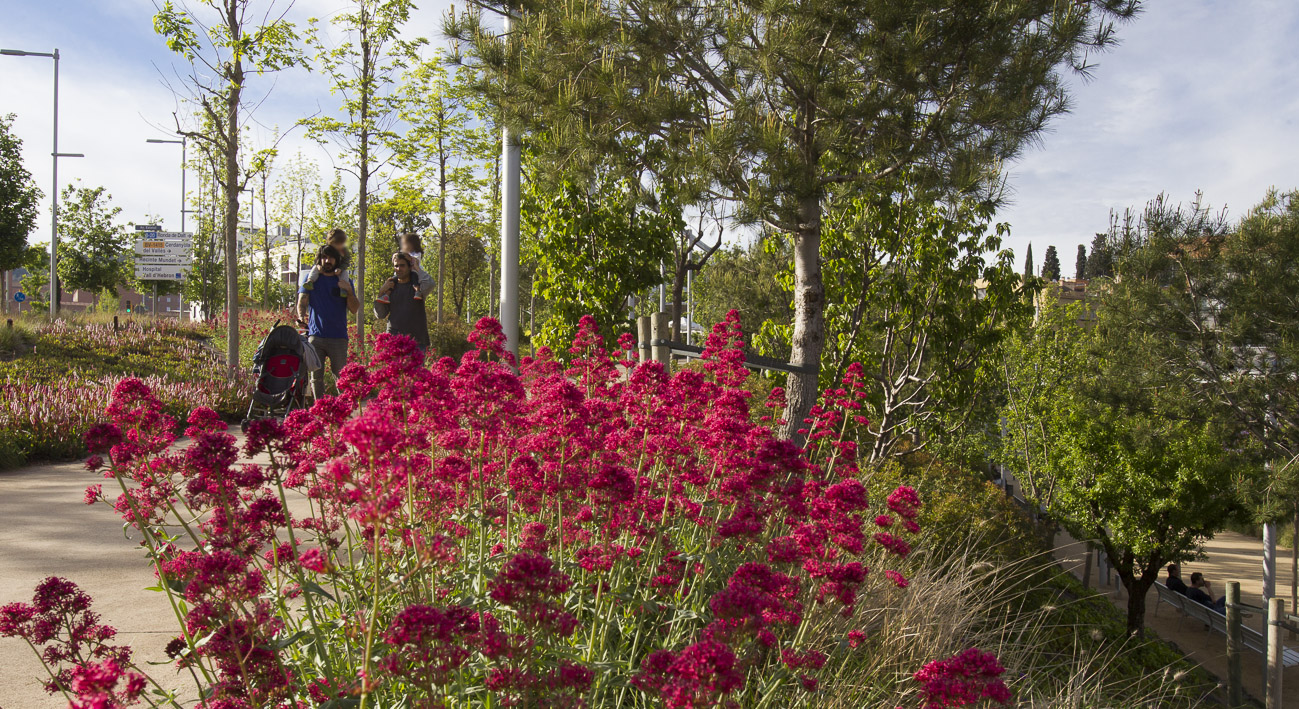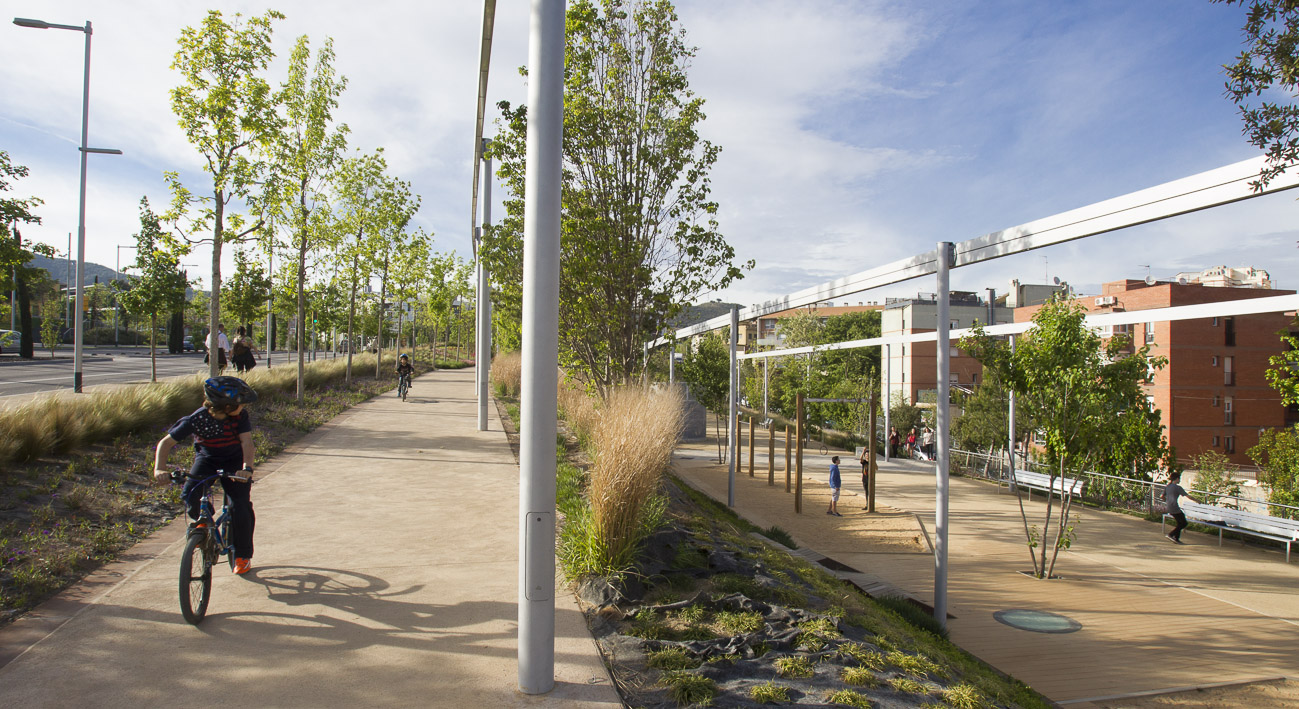Proximity to Collserola makes this park a biodiversity link between the mountain range and the city. It lies over the Rieres d’Horta rainwater regulation tank and a depot for the Horta-Guinardó district’s street-cleaning services.
The park boasts numerous plants and has adopted significant renaturalisation innovations, which include planting natural-sized trees that enable a high density of biomass to be obtained and boost the Collserola connection, energy self-sufficiency criteria, with a 642 m2 solar-panel pergola that harnesses the sun’s energy, and LED public lighting, which is managed remotely, according to demand.

Biodiversity
Its trees include cypresses (Cupressus sempervirens), Aleppo pines (Pinus halepensis), multi-stem field maples (Acer campestre ), strawberry trees (Arbutus unedo), ash tree (Fraxinus berlandierana), almond trees (Prunus dulcis / amygdalus), holm oaks (Quercus ilex), downy oaks (Quercus pubescens), silver maples (Acer saccharinum), hackberry trees (Celtis australis), ginkgos (Ginkgo biloba), callery pear trees (Pyrus calleryana), bald cypresses (Taxodium distichum), orchid trees (Bauhinia purpurea), multi-stem plane trees (Platanus x hispanica), Armenian plum trees (Prunus armeniaca), purple-leaf cherry plum trees (Prunus cerasifera), bird cherries (Prunus padus / mahaleb), service trees (Sorbus domestica). Notable specimens include some recovered from the original site, before the work on the park had finished in 2013, such as Norfolk Island pine
trees (Araucaria heterophylla), and several Judas trees (Cercis siliquastrum) and jacarandas (Jacaranda mimosifolia).
Its shrubs include common boxwood (Buxus sempervirens ), cistuses (Cistus), dwarf cheesewood trees (Pittosporum tobira nana), abelias (Abelia x grandiflora), false olive trees
(Phillyrea angustifolia), mastic trees (Pistacia lentiscus), laurustinuses (Viburnum tinus), Japanese spurge (Pachysandra terminalis), Asiatic jasmine
(Trachelospermum asiaticum), kiss-me-quick (Centranthus ruber), southern globethistle
(Echinops ritro), Joe-Pye weed (Eupatorium purpureum ‘Atropurpureum’ ), pink gaura (Gaura lindheimeri ‘Siskyou Pink’), dwarf lilyturf (Ophiopogon japonicus), red bistort (Persicaria amplexicaulis ‘Vermella’), Himalayan bistort Persicaria affinis, society garlic (Tulbaghia violacia), purpletop vervain (Verbena bonariensis), slender vervain (Verbena rigida), tufted hairgrass (Deschampsia cespitosa), needle grass (Nassella tenuissima), switchgrass (Panicum virgatum ‘Shenandoah’), and Chinese fountain grass (Pennisetum alopecuroides).

Landscaping and Design
An accessible path runs lengthwise through the park, taking visitors up to the green areas as well as the services and facilities. On the first terrace there is a solar-panel pergola, which provides shade for the official skittles and pétanque courts, plus a bar and public toilets. Lighting is provided by 921 LED lights mounted in the walls, which help to guide pedestrians along the routes that cross the park. The second terrace has a health and sports circuit, especially for older people, while the third terrace has an accessible children’s play area and the last one has a central space with a compact, gravelled surface, paved areas with steps, and a tree-lined stage for holding neighbourhood events.
The layout of the trees ensures the resting areas offer shade in the summer and sunshine during the winter. The park uses LED technology, rainwater for irrigation and solar energy for its lighting system.
-
- Phone number
- Tel.: 010
-
- Titularity
- Public center
- Address:
- Av Estatut de Catalunya, 21
- Districte:
- Horta-Guinardó
- Neighborhood:
- la Clota
- City:
- Barcelona
- Sections of this equipment
- Espai amb jocs d'aigua
- Espai per a gossos deslligats al parc de les rieres d'horta
- Àrea de joc infantil
- Wc públic
El parc s'ubica en l'àmbit format per la plaça de Botticelli, la plaça de l'Estatut, l'avinguda de l'Estatut i el carrer de Jerez.
Esdeveniments
-
Renova la teva roba a la Clota Market
From 06/05/2024 to 11/05/2024






